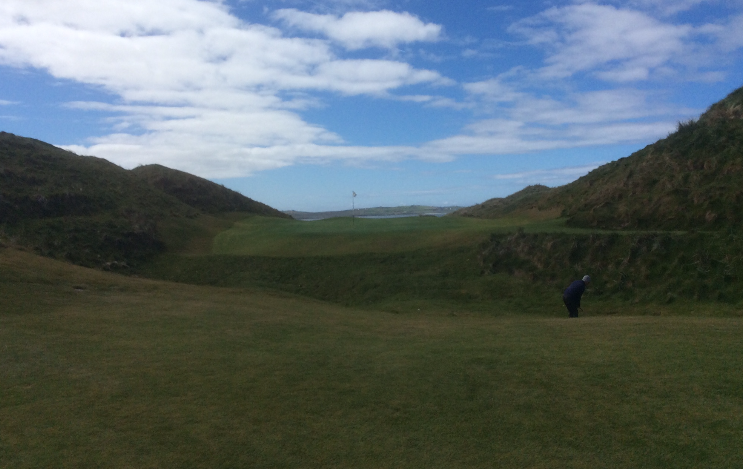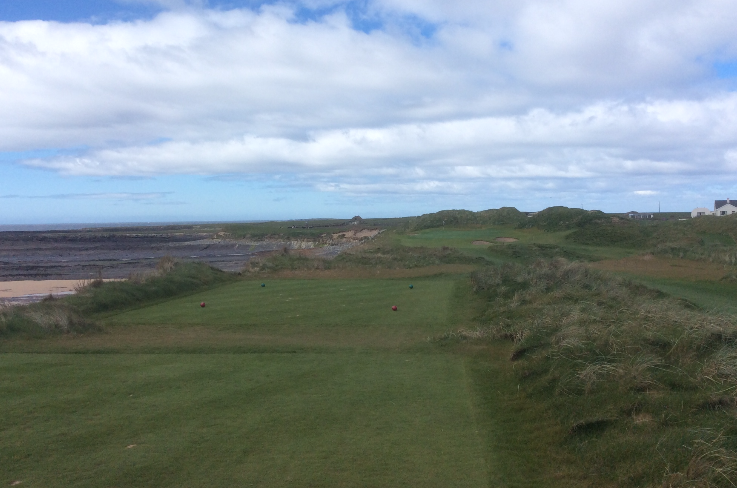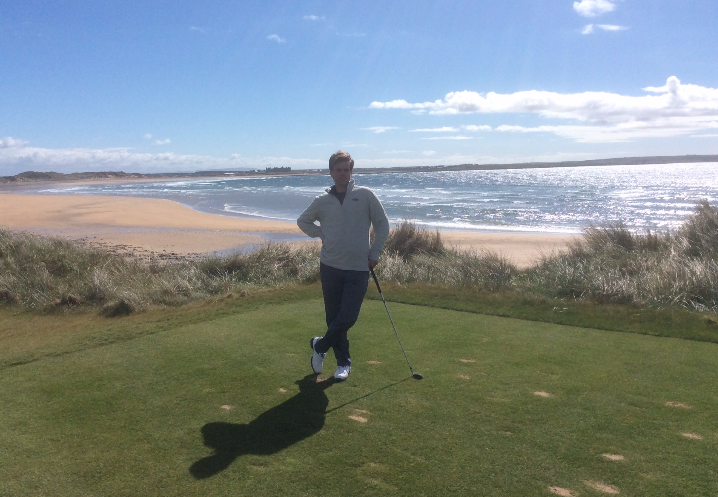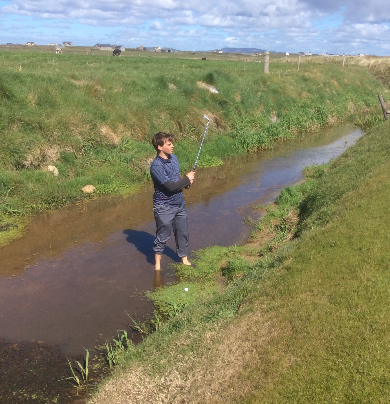Trump International Golf Club of Doonbeg
- alexanderjhogan
- May 25, 2016
- 10 min read
Doonbeg is located on the coast between Lahinch and Ballybunion (approximately 30 minutes south of Lahinch). It is a Greg Norman design that opened in 2002, but has been undergoing a redesign since Donald Trump bought it in 2014. When I booked our tee time a few months earlier, I was informed that only nine holes would be open because the other nine were undergoing a renovation as part of the redesign. I knew this was going to be our second round of the day, so nine holes at a deeply discounted price was fine with me. A month before our date of play, I received another email informing us that only eight holes would be open (with a corresponding drop in the green fee). Again, the course was directly on our way to Ballybunion, so I did not care. Then, a week before we were set to play, I got yet another email informing me that only seven holes would be open (the renovation was going slower than expected), but the resort would let us play the seven holes as many times as we liked. Ultimately, we wound up playing 14 holes for 30 euro a person. We thought it was a pretty good deal and, though I can't really say that I have played Doonbeg, I did get a good flavor for what the full 18 would offer. I will say that I did appreciate the constant communication from the course informing me of the situation and always giving me the choice to cancel my tee time.
Other people we encountered in Ireland seemed skeptical of Doonbeg. For example, the starter at Lahinch wrinkled his nose when we told him we were playing Doonbeg later. When he learned only seven holes were open, he laughed and asked us how much the course was charging us for that (seemingly indicating his belief that the course is generally overpriced). I will note, though, that at Doonbeg I went in eyes wide open knowing how much I was paying and for which holes, while at Lahinch I did not know that I would be unable to play one of its most famous holes (the par three fifth). Perhaps Doonbeg is suspect because it is new. Here is a course built in 2002 by an Australian and now owned by an American trying to include itself on the classic Irish golf circuit between Lahinch (founded in 1892) and Ballybunion (founded in 1893). Or maybe it is because there is no local feel to Doonbeg. It is unabashedly a five-star luxury resort that caters to wealthy travelers. That atmosphere is in stark contrast to Lahinch and Ballybunion. As I note in my review of Lahinch, the course's local feel reminds you of a municipal course in America and both Ballybunion and Lahinch are located right in town. By contrast, Doonbeg's clubhouse is a secluded castle far from any town center. I try to not get hung up on these issues. The Bandon Dunes resort is brand new, but contains some of the best courses in the world. Lahinch is old and awesome. If there is a six-star resort, Pebble Beach is it and that is great. Bethpage is as far from a five-star experience as you can get, but that is part of the charm. St. Andrews is in the middle of a town and (I imagine), one of the best golfing experiences you can have. All this to say, there is no one thing that makes a great golf course. Either I like a golf course or I don't and various factors will contribute or detract from my perception, but there is no secret formula that leads to a positive or negative experience. As I said about Lahinch, being in the middle of town added to its appeal. At Pebble Beach, however, the stretches of holes where you realized you were close to civilization took away from the golf course. Different things work at different places, so I never categorically assume something will be bad or good.
Overall, my takeaway from Doonbeg is that it is beautiful, difficult, and different. Not only were its ocean views spectacular, but its golden fescue framing every fairway was different than anything we saw in Ireland. It was this fescue that made the course difficult and different. Lahinch also had its fair share of fescue, but it was nothing compared to Doonbeg. Not only was Doonbeg's fescue much thicker, but it was also closer to the fairways. At Doonbeg, I felt like my ball either landed in the fairway/green or in the fescue. At Lahinch, there was rough between the fairway and the fescue. For a good comparison, take your typical American course. Instead of there being fairway, rough, then forest, imagine if there was only fairway and forest such that if you missed the fairway your ball is in the woods. That is Doonbeg. I often found myself hitting tee shots that would miss the fairway by 5-10 yards and, instead of being playable from the rough, lost in the fescue (if you hit it in the fescue the chances of finding your ball were about 50/50). In my opinion, Doonbeg was too difficult. I shot 91 at Lahinch and 84 at Ballybunion (the two courses I played before and after Doonbeg). So, I was playing pretty good golf. We didn't bother to keep score thoroughly at Doonbeg because we were only playing the seven hole loop, but I wouldn't be surprised if I shot 20 over in 14 holes. I would certainly go back to Doonbeg because it was beautiful, challenging, and (owing to the fescue) different than any course I played in Ireland, but, because it was so hard, it may have been the least fun I had on a golf course in Ireland (to be sure, I was still smiling, but not quite as widely as when playing other courses). Perhaps I'll just move up to the ladies tees next time and try to break ninety that way.
As to the resort, it is indeed beautiful. I don't know if the clubhouse is an actual old castle or just looks like one, but, if fake, it is convincing. And yes, there are pictures of Donald trump everywhere, though the resort is not covered in gold, as you might expect if you have only visited his properties in America. When I return, I look forward to playing a full eighteen and spending a night in the hotel or in one of the many lodges on the property.
Now, onto some individual holes (and, remember, we only played a handful of the holes, but did so twice).
The fourth hole (where we started) is a 592 yard par five. If you are thinking that you will be lucky to not have to open on a long par five if you start from the proper first hole, you are wrong. The true first hole is 567 yards, and, yes, such a monster opening hole is tough (especially if playing into the wind as we were that day). The entire hole is about avoiding bunkers. If there was ever a true three shot hole, this is it and bunkers come into play on every shot. For me (especially into the wind), it was a driver, fairway wood, fairway wood.
***On all of my reviews, you can now click on the first image to see a slideshow of all images on the page.
Fourth tee.
The fifth was one of the most enjoyable holes I played in all of Ireland. A 373 yard par four that requires your tee shot to go through a chute of dunes leading to the fairway. The green is also nestled between dunes with the ocean as its backdrop. If that were not enough, there is a severe false front to the green leading to a deep swale full of high grass in front of the green (which either comes into play by hitting your approach short of the green or on the front edge of the green and having it roll off).

Fifth tee.

Fifth green with my brother hitting from the swale.

Ocean behind fifth green.
After playing four and five we moved to the eight- another beast of a par five measuring 580 yards. Yes, the par fives are no joke here- 567, 592, 582, 580 and 500 (the only one whose length does not raise an eyebrow). This hole is rated as the hardest on the course and it no doubt was. Not only long, but uphill and there is no room to hit shots wide of the fairway, as you will lose your ball in the fescue. This hole ate my brother alive the first time we played it, and my father both times. Below is a Google Earth shot of the eighth hole. You can clearly make out the fairway. Anything not in it is dead.

Eighth hole from above.

View from eighth tee. This gives you a good idea of how thick the fescue is. As opposed to Lahinch where you would usually
find your ball in the fescue, you usually did not at Doonbeg.

If fescue was not enough, be sure to avoid the enormous fairway bunkers (and green side bunkers, which you can see
in the distance).
The ninth was one of our favorite holes on the trip- a 175 yard par 3 with one of the best ocean views we had on any course. Have no doubt, the ocean on the left can come into play, though the wind will often be coming off the ocean to push errant balls back towards land.

Ninth tee.

Looking backwards from ninth tee with the clubhouse in the distance. You are very far away from the clubhouse on the
ninth tee, so you can imagine how big the clubhouse is.

Panoramic shot of the ninth green. I had no idea cameras could do this nowadays until my brother showed me. I guess the future is here.
The tenth is another long par five at 580 yards. This is a tough hole that requires you to think through your shots. The tee shot is not particularly difficult with a wide fairway and only one bunker to avoid. It are the second and third shots that are tough. Your second shot needs enough distance to clear a creek running through the middle of the fairway. After clearing it with your second shot, the creek now runs up the entire left side of the hole to the green. Because it is a 580 yard hole, it is quite possible your third shot will still be a mid-iron, so pulling it 10 yards left is not out of the question, especially with the fescue protecting the right side of the green. I had a lot of fun on this hole. I pulled my third shot into the creek, but the creek was shallow enough that my ball was sitting up on a tuft of moss (with water underneath it). I have never tried to hit a ball out of water (similar to Bill Haas hitting an explosion shot from a lake with the FedEx Cup on the line). When I approached the ball, it looked to enticing not to try. So, I took off my shoes and socks and got in the creek. I nestled my feet into the mud like it was sand in a bunker. In fact, I think the advice TV commentators give is that hitting a shot from a shallow water lie is similar to hitting a bunker shot. Open the club face and use the water to propel the ball upward instead of hitting the ball itself. Disaster in the making you might think? No! Straight out it came and onto the green. To be sure, it was not like Bill Haas hitting it to 3 feet. Mine ended up about 25 feet from the hole. I then started the process of drying my feet, cleaning them, and getting dressed. And, yes, I missed the putt.

Tenth fairway with the creek directly in the forefront and then running up the left side.

Getting ready to hit from the water.
Eleven is another good par three measuring 148 yards. The green is severely sloped and protected by some of the deepest bunkers we saw in Ireland. It is a generous landing area for your 148 yard club, though it is slightly uphill, which may require a bit more club than you think (especially with those bunkers staring at you).

Eleventh tee.
The twelfth is a 401 yard par four that does not have much to it. Other than two bunkers by the green, the only difficulty on the hole comes from its narrow fairway, though that is the norm at Doonbeg. As you can see below, the tee shots are simply intimidating. It is like hitting to a fairway surrounded by lava. The fescue is so prominent (and beautiful) your eyes are simply drawn to it, but that is exactly where you can't hit it.

Twelfth tee.
That was the end of the loop. With literally nobody else on the course, we went around again and had a grand time. Doing this review made me remember how beautiful Doonbeg is. As I said in the introduction to this post, it was a bit too hard. Not only was it long, but it also required precision unlike any other course we played in Ireland. Part of the problem is that there are only three sets of tees to choose from. There are the women's tees (5261 yards), the yellow tees (6361 yards) and the white tees (6911 yards). Accustomed to 6800 yard tees at home, we opted for the whites. This may simply have been the wrong choice in light of the wind, elevation changes, and narrowness of the course. Also, I often find that par fives tend to be the least interesting holes on a course (with there being exceptions of course). There are five of them on Doonbeg, four of which are very long. But, given how beautiful Doonbeg is, I very much want to go back, play from the yellow tees, and properly enjoy the course. Of the seven world class courses we played, Doonbeg was my fifth favorite. That is not to say I would not be excited to play it again. I most certainly would be and suggest that any person traveling to the west coast of Ireland play it. Like I keep saying, whenever I rank these course, it is always relative. It is rare that I simply do not like a golf course and would not want to return (that only happened once in Ireland, which I will explain in my Waterville review). Instead, it simply means that if you only had four rounds to play in Ireland, I would not suggest that Doonbeg be one of them. I particularly want to return to Doonbeg because we only experienced seven holes. Though I think it gave a good flavor of the course, I am sure there are many exceptional holes we were unable to play.
Oh, and perhaps coloring my whole review of Doonbeg is the fact that I lost my match with my brother. The wager was that the loser would have to run into the 55 degree ocean when we got to Ballybunion later that evening. I have a video of that also, but some things have to remain private.
If you only have five days in Ireland, a great itinerary would be Lahinch, Doonbeg, Ballybunion (Old), Ballybunion (Cashen), and Tralee. Start in Lahinch and work your way down to Tralee. This route would allow you to play five great courses and never require you to drive more than 40 minutes from one destination to the next. The next time I return to Ireland, I will not actually be going to Ireland but rather Northern Ireland. The next time I return to Ireland, I will likely do this one-week trip outlined above.




























Comments